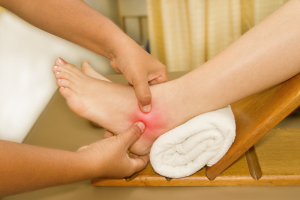As there is no uniform cause for ankle pain, treatment of ankle pain needs to be individualized according to the underlying pathology. Here are some common ankle conditons and their usual treatment protocols.
Arthritis of the Ankle Joint
This is another very common condition and as it has been mentioned in the table above can be due to inflammation (rheumatoid arthritis, gout, pseudogout, ankylosing spondylitis etc.), degeneration (osteoarthritis) or septic (various inectious agents). The therapy is directed at the specific cause and can be found under the various headings elsewhere in this chapter.
Circulatory Reasons for Ankle Pain
In the case of Buerger’s disease where the arteries to the legs contain narrow passages, the only rational approach is to identify the arterial lesions by angiograms (X-rays of the arteries after infection of dye into the arteries) and subsequent bypass surgeries by a vascular surgeon.
The results of this surgery can be very rewarding as the patient had to stop every 1 or 2 blocks with walks before the surgery and after the surgery there are suddenly no limitations. With venous insufficiency and varicose veins the veins can often be obliterated by a series of injections. If this alone does not lead to the success, surgical removal of the veins with damaged valves can be done except for the deep veins. However, the process of damage to the valves of the deep veins is halted by removing the dilated superficial varicose veins. This condition seems to be constitutional in certain families. A vascular surgeon can be very helpful in these cases.
Nerve Entrapment
In this condition there is often an area of numbness associated often with a muscle weakness due to the compression of a nerve that travels through a tunnel formed by a bony or ligamentous structure. Electromyography studies, which are usually done by a neurologist or by a physiatrist, will help to identify, which nerve is compressed. A common nerve involved is the posterior tibial nerve causing tarsal tunnel syndrome. An orthopedic surgeon or a neurosurgeon can then “decompress” this nerve in a daycare type surgery. If this is done early enough there will not be any residual weakness in the nerve or the associated muscles and all of the sensitivity loss usually returns to normal.
References:
1.The Merck Manual, 7th edition, by M. H. Beers et al., Whitehouse Station, N.J., 1999. Chapter 49.
2. Goldman: Cecil Textbook of Medicine, 21st ed.(©2000)W.B.Saunders
3. Ferri: Ferri’s Clinical Advisor: Instant Diagnosis and Treatment, 2004 ed., Copyright © 2004 Mosby, Inc.
4. Rakel: Conn’s Current Therapy 2004, 56th ed., Copyright © 2004 Elsevier
5. Suzanne Somers: “Breakthrough” Eight Steps to Wellness– Life-altering Secrets from Today’s Cutting-edge Doctors”, Crown Publishers, 2008







